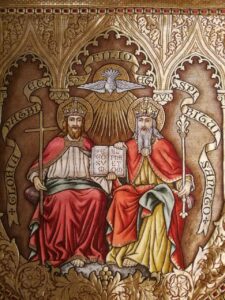 With the Solemnity of Pentecost last Sunday, the Easter Season came to an end. On Monday, we began Ordinary Time, that is, the period when priests wear the colour green, a time during which we are called to live the Gospel in the ordinariness of everyday life, witnessing the joy of being disciples of the crucified and risen Jesus. If we were to pause and look back a moment, we would be able to visualize a unique image. From a balcony in the heavens, God the Father, aware of how humanity after Adam and Eve’s sin (see Gn. 3) had gone astray and was unable of finding the way back to heaven, sent the prophets to help them find that way. But humanity not only failed to heed them, they also killed them (see Mt. 23:29ff.).
With the Solemnity of Pentecost last Sunday, the Easter Season came to an end. On Monday, we began Ordinary Time, that is, the period when priests wear the colour green, a time during which we are called to live the Gospel in the ordinariness of everyday life, witnessing the joy of being disciples of the crucified and risen Jesus. If we were to pause and look back a moment, we would be able to visualize a unique image. From a balcony in the heavens, God the Father, aware of how humanity after Adam and Eve’s sin (see Gn. 3) had gone astray and was unable of finding the way back to heaven, sent the prophets to help them find that way. But humanity not only failed to heed them, they also killed them (see Mt. 23:29ff.).
In the end, moved with compassion, the Father sent His only Son: “And the Word was made flesh and made his dwelling among us” (Jn. 1:14). Jesus, the Son of God, shared everything about our human condition with us except sin, helping us to remember that we are created by God, that we are His children, and that God is our Father. Through His words and His life, He taught us with Truth regarding the Way to return to the Father, who is eternal Life. Thus, Jesus showed us the Father’s face: “Whoever has seen me has seen the Father” (Jn. 14:9). He reminded us that the way to heaven is open to everyone, that there is no need to be afraid, and that we do not need to be ashamed because God the Father is love, He is faithfulness, He is mercy. Obedient to the Father, Jesus died on the cross for our salvation. On the third day He rose, defeating sin and death, thus opening the way to return to His Father and our Father (this is what we celebrated on Easter Sunday).
We can confidently choose this Way because Jesus, having ascended into heaven, gave us the Holy Spirit on Pentecost (the Solemnity celebrated last Sunday), the first gift given to believers – the Person of Love poured out into our beings so we might live as children of God. This is how we can understand why the liturgy invites us to celebrate the Solemnity of the Holy Trinity, Father, Son and Holy Spirit. This Solemnity is a sort of synthesis and, above all, directs us toward the goal of our journey.
This God, who presents Himself as One and Triune, is not all that distant as it seems, but is so very close that He becomes Bread broken for us, Corpus Christi (which will be celebrated next Sunday). This Bread, the Bread of angels, nourishes us on our journey toward heaven. This gift then reveals the Most Sacred Heart of Jesus, celebrated the Friday following Corpus Christi.
These three liturgical feasts are a synthesis of the mystery of our faith which we have lived in these last months: from Christmas to the death and resurrection of Jesus, from His Ascension to Pentecost. The Arian heresy, which disputed Jesus’s divinity and His bond with the Holy Trinity, was condemned by the Council of Nicea in 325 and Constantinople in 381. These two Councils were providential in spreading the doctrine regarding the Trinity both through preaching and through devotion. As early as the 8th century, liturgical prefaces appeared containing references to the doctrine of the Most Holy Trinity. A votive Mass emerged toward the year 800 in honour of the Trinity, which could be celebrated on any Sunday. This decision was opposed because the Trinity is honoured every Sunday. In the end, it was Pope John XXII who established the feast throughout the universal Church in 1334.
